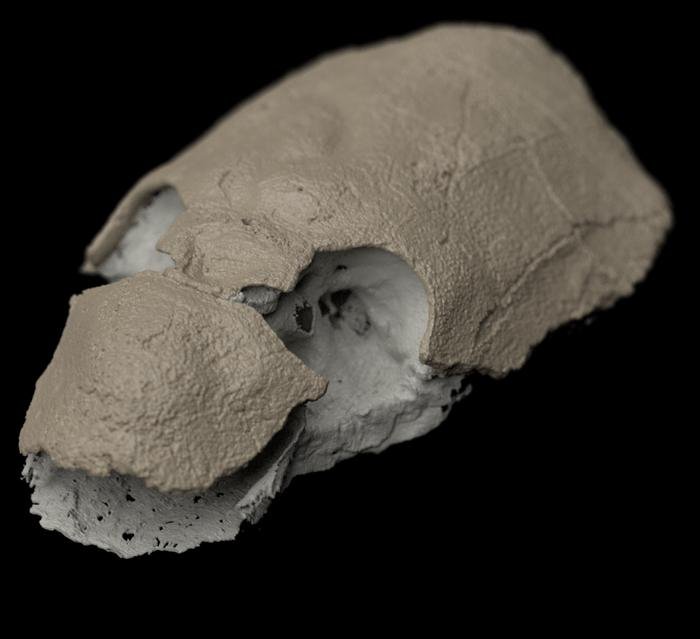Jan Bartek – AncientPages.com – A new analysis of the bones and muscles in ancient fish gives new clues about how the shoulder evolved in animals – including us.
The shoulder girdle – the configuration of bones and muscles that in humans support the movement of the arms – is a classic example of an evolutionary ‘novelty’. This is where a new anatomical feature appears without any obvious precursors; where there is no smoking gun of which feature clearly led to another.

A CT scan of a fish fossil in the study. Credit: M. Brazeau & M. Castiello
The new research, which draws together a range of evolutionary investigation techniques including fossils, developmental biology, and comparative anatomy, suggests a new way of looking at how major anatomical features like shoulders evolved.
One theory of the shoulder’s origin is that it was part of how fins formed in pairs on either side of the fish body, the evolution of which allowed fish more swimming control and eventually spurred the move from water to land. The ‘gill-arch’ hypothesis suggests that these fins evolved from the bony ‘loops’ that support the gills, which also formed the shoulder. However, it has been difficult to gather any evidence for this hypothesis, as the features are rarely preserved in fossils.
A different theory of how the fins formed, the ‘fin-fold’ hypothesis, suggests the precursors of the paired fins instead evolved out of a line of muscle on the flanks of the fish. This theory has gained a lot of supportive evidence in the 150 years since both were proposed, but it cannot explain how the ᴀssociated shoulder girdle evolved.
Now, by reanalysing an ancient fossil fish skull from soon after the shoulder girdle emerged, alongside other lines of evidence, the team suggest the truth may lie in a modified version of the gill-arch hypothesis that reconciles it with the fin-fold hypothesis.
The fossil the team looked at is a placoderm, of the species Kolymaspis sibirica, which lived around 407 million years ago and was among earliest jaw-bearing fishes. The fossil has a well-preserved brain case – the hard inner parts of the skull that record imprints and other features of the brain.
Dr Brazeau realised that despite the poor or absent preservation of the gill arches in such fossils, evidence for them could be well preserved in the brain case: the cartilaginous or bony ‘box’ that surrounds the brain and supports the sensory structures like eyes and ears. The brain case showed a curious head-shoulder joint highlighted by the configuration of muscles and blood vessels.
By comparing this feature in the jawed fish fossil with the brain case features of their precursors, the jawless fish, he and the team discovered new ways the two could be compared. They found the unusual head-shoulder joint bears similarities with the gill arches in earlier fish, suggesting it was these that were retained and incorporated into the formation of the shoulder at an early stage.
While most jawless fish have 5-20 gill arches, jawed fish almost never have more than five. Combining this with the new brain-case evidence, the team suggest the sixth gill arch was incorporated into the shoulder, becoming a crucial boundary that separated the head from the body. Intriguingly, the blood supply to the fins of jawless fishes emerges between the sixth and seventh gill arches.
Dr Brazeau, from the Department of Life Sciences at Imperial, said: “The gill arches seem to have been involved in the early separation of the head and body via the shoulder. But we no longer have gill arches – though the shoulder was templated on them, they don’t need to still be around today.
“This is consistent with some earlier studies that showed muscles can remain highly stable, while the specific bones that support them gradually take over one from the other. Gill arches may have done their part and been replaced as the shoulder took on a new configuration, including supporting things like our necks.”
This finding also means it doesn’t have to be an either/or in terms of how the paired fins evolved. Dr Brazeau added: “Our study shows how there is merit to both theories without accepting one or the other wholesale. Instead, we can rationalise the areas that overlap.”
Dr Zerina Johnson, Researcher at the Natural History Museum, adds: “The team will next focus on specimens from the Natural History Museum’s fossil fish collection. This will include jawless fish that have fins but lack a distinct shoulder girdle.
“We are currently processing many gigabytes worth of data, and I can hardly wait to see what these important specimens from the collection will add to the story”.
The results of the study, led by Imperial College London’s Dr Martin Brazeau and Natural History Museum researchers, are published today in Nature.
Written by Jan Bartek – AncientPages.com Staff Writer





